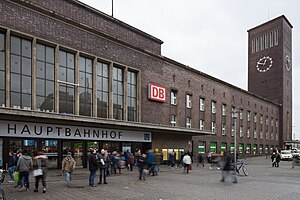Düsseldorf Central Station
|
Düsseldorf Hauptbahnhof
|
|
|---|---|
| Through station | |

Entrance hall of station
|
|
| Location |
Düsseldorf, North Rhine-Westphalia Germany |
| Coordinates | 51°13′13″N 6°47′34″E / 51.22028°N 6.79278°ECoordinates: 51°13′13″N 6°47′34″E / 51.22028°N 6.79278°E |
| Line(s) | |
| Platforms |
|
| Construction | |
| Architect | Krüger and Eduard Behne |
| Architectural style | New Objectivity |
| Other information | |
| Station code | 1401 |
| DS100 code | KD |
| Category | 1 |
| Website | www.bahnhof.de |
| History | |
| Opened | |
| Traffic | |
| Passengers | 250,000 daily |
| Düsseldorf Airport S-Bahn service | ||||||||||||||||||||||||||||||||||||||||||||||||||||||||||||||||||||||||||||||||||||||||||||||||||||||||||||||||||||||||||||||||||||||||||||
|---|---|---|---|---|---|---|---|---|---|---|---|---|---|---|---|---|---|---|---|---|---|---|---|---|---|---|---|---|---|---|---|---|---|---|---|---|---|---|---|---|---|---|---|---|---|---|---|---|---|---|---|---|---|---|---|---|---|---|---|---|---|---|---|---|---|---|---|---|---|---|---|---|---|---|---|---|---|---|---|---|---|---|---|---|---|---|---|---|---|---|---|---|---|---|---|---|---|---|---|---|---|---|---|---|---|---|---|---|---|---|---|---|---|---|---|---|---|---|---|---|---|---|---|---|---|---|---|---|---|---|---|---|---|---|---|---|---|---|---|---|
|
||||||||||||||||||||||||||||||||||||||||||||||||||||||||||||||||||||||||||||||||||||||||||||||||||||||||||||||||||||||||||||||||||||||||||||
Düsseldorf Hauptbahnhof is the main railway station of Düsseldorf, the state capital of North Rhine-Westphalia, Germany.
The station was opened on 1 October 1891. It replaced the three following stations:
Both the Bergisch-Märkische and the Cologne-Minden stations were on the southern edge of the city and were in the way of the construction of Friedrichstadt. The wish to clear the way for the new development was a reason to build a new station in addition to the desire to bring together the stations and lines following the nationalisation of the railway companies of Rhineland-Westphalia between 1879 and 1882.
The original Hauptbahnhof was built in the Wilhelmine style. After three decades it had become too small and its style had become unfashionable. In November 1930, eight designs were submitted to the public as part of a competition to redesign the station. The station building was built from 1932-1936 conforming to a design dictated by the Reichsbahn directorate of Wuppertal and its architects, Krüger and Eduard Behne. It features a notable clock tower.
The station underwent major reconstruction in the 1980s, finishing in 1985, when the Stadtbahn lines passing under the station were opened. This reconstruction involved the remodeling of the old ticket offices into a food court, the installation of lifts and the opening of the station toward the city borough of Oberbilk, where, at the western exit of the station, new office buildings were erected on the site of a former steel works. The former 1st class waiting room has been remodeled into a hotel and a discothèque.
Some minor changes were carried out in the year 2005; the old toilets from 1985 were torn out to make room for a fast food restaurant, a small 1st class lounge was installed in the northern passenger tunnel also. The dated ceilings and information systems in the passenger tunnels are scheduled for replacement also, as they do not meet current fire protection standards.
The station is frequented by roughly a quarter million passengers per day and is therefore Germany's fourth busiest station. All modes of rail transport are offered on the 20 main line tracks (16 platforms currently in use), including InterCityExpress, InterCity and EuroCity trains for long distance travel, DB NachtZug, D-Nacht and EuroNight overnight trains as well as RegionalExpress, RegionalBahn and S-Bahn services for regional distribution. The station is integrated into the Rhein-Ruhr S-Bahn network and local traffic operates under the Verkehrsverbund Rhein-Ruhr transport association. The subterranean station, operated by Rheinbahn, has 4 tracks that are part of the Stadtbahn lines of Düsseldorf. The 6 tramway stops in front of the station connect the Hauptbahnhof to the local tram network, also operated by Rheinbahn.
...
Wikipedia
